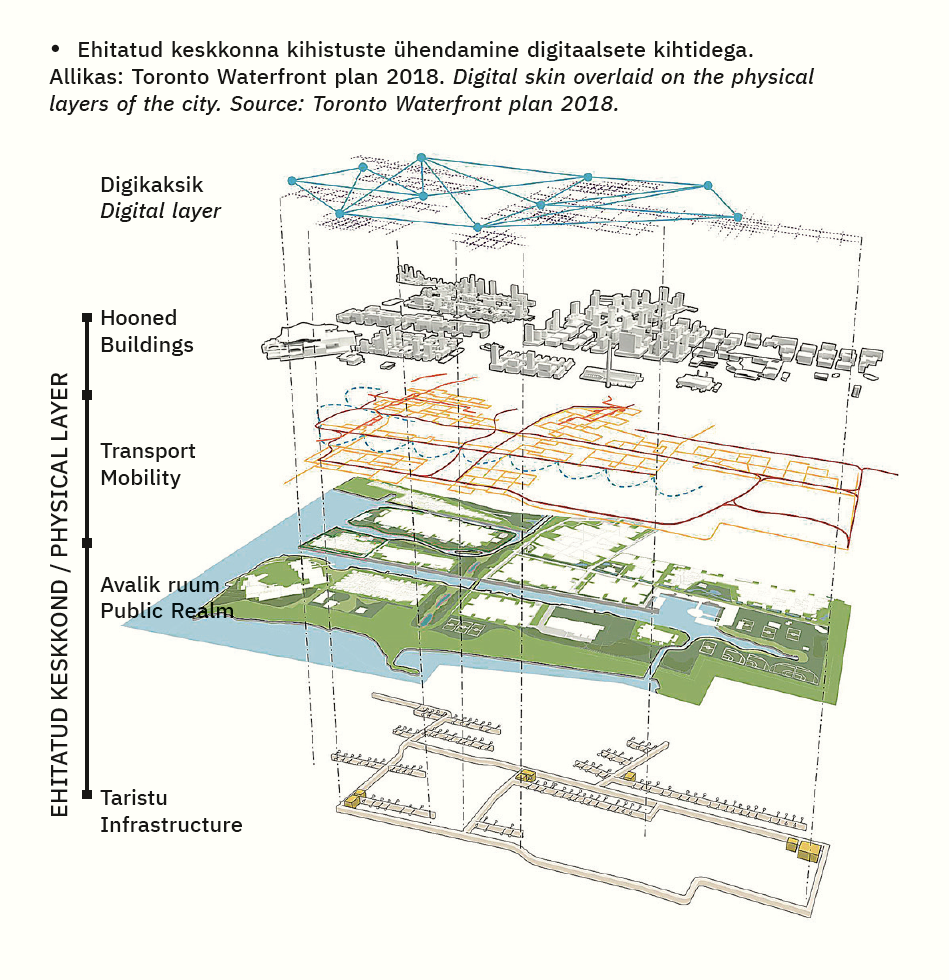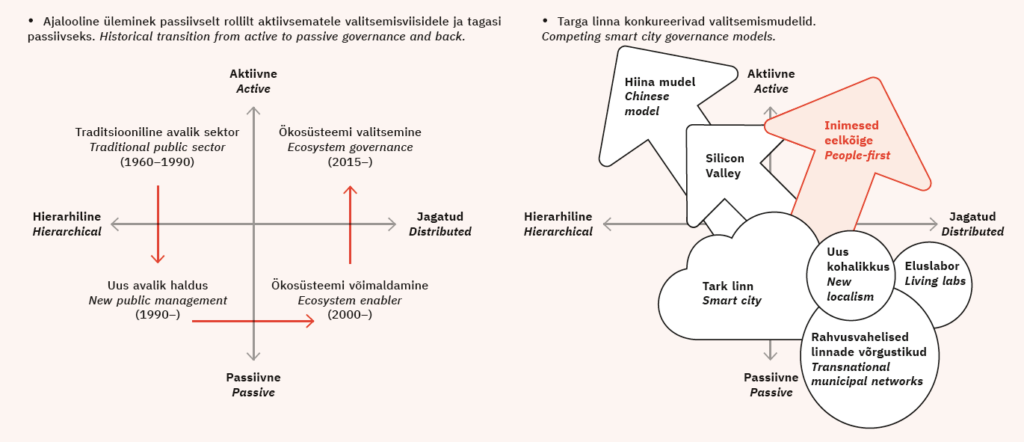People-first is a model for cities in the global age where local governance takes an active role to guarantee equal opportunities and people gain the agency to codesign the use of cities and infrastructures. It is the result of a collaborative process of Demos Helsinki and four of the largest cities in Finland: Espoo, Helsinki, Tampere, and Vantaa.
Introduction: We are entering a new phase of smart city development
Smart city development is at the crossroads, where power and politics have become central to the way digital technologies are used in cities. Widespread criticism of how digital technologies are used to monitor, control and manipulate people, is endangering the legitimacy of the smart city project. At the same time this model can also be used to centralise and take power away from citizens and public administrations, who don’t have the tools and capacity to operate or even analyse the data of smart-city technologies. The primary goal of the smart city model is to seek efficiency through digitisation in the operating environment of our cities, leading to a phase of competing models of governing the city and its citizens.
Despite the fragmentation of smart city developments, the promise of digital technologies and governance models for cities remains unparalleled. This promise is most evident in advancing the efficiency of the built environment and other urban infrastructure, offering new ways to govern urban dwellers and foster collaboration. This is a critical element of a well-functioning city of the 21st century, as the need for digital tools is not going to disappear.
For the past ten years, the term ‘smart city’ has referred to the digitalisation of the urban sphere. Until recently, the overall aim of smart cities was to improve data-driven management of their different functions, from traffic management to participation. In other words, smart cities sought to increase efficiency, primarily through optimising the operations of the city (i.e., compartmental optimisation).
The rise of Smart city development can be divided into three distinct phases. The first two have been well-documented (and thoroughly critiqued in the academic literature), but the third one is only now emerging. This new phase brings power and politics to the table, meaning that there is no longer a single smart city model with the ultimate aim of increasing efficiency but several competing ideas of what a good smart city is of.
- The ICT-driven control phase (2008–2015), also known as technology and ICT-oriented approach, focused on the efficiency of infrastructure and technology (e.g., energy, transportation, communication, waste, water) by making use of ICT. In this phase, smart cities integrated and monitored all of their critical infrastructures, optimised their resources, planned their activities, and, in this way, maximised their services. They did so by optimising infrastructure but also by increasing collaboration among economic actors, providing more efficient services to citizens, and ‘supporting innovative business models across private and public sectors.’ 1
- The bottom-up apps for consumers and citizens phase (2010–2017), also known as people-oriented approach, grew partly in reaction to the ICT-driven approach, but also as a byproduct of smartphones and the apps that they offered to people. In this phase, the smart city was understood as a way of enhancing the quality of life of individual citizens, both in terms of user satisfaction and participation.2 The latter were seen to boost the attractiveness, attachment, and, consequently, the prosperity and competitiveness of the city.
- The power phase (2017–) is the third wave of smart city development. The intersection of the city and digital platforms (such as the US-based ‘super platforms’ Apple, Amazon, Microsoft, Google, Facebook, and China-based Alibaba and Tencent, as well as more specialised platforms such as Uber, Lyft, Airbnb, Spotify, and Twitter) is especially interesting, as platforms serve mostly urban dwellers. Platform companies are different from regular firms in two key aspects. First, they enable direct interactions between two or more distinct parties. Second, each party has to make platform-specific investments in order to directly interact with others. The combination of these two aspects creates unique levels of network externalities (adding more users adds to the value of the platform) and increases switching costs. While the third phase is already rapidly evolving, it is not making the problems and aims of the first two phases obsolete but merely adding to the already complex nature of smart city development. This new phase involves centralisation of power and shifts it away from city and national governments—a key point of distinction from the previous phases of smart city development.

The promise of digitalisation of cities is paramount
Despite the nonlinear and uneven development of the smart city approach, the promise of digital technologies is vast. It is unparalleled in three fields: efficiency of the built environment, governing people, and facilitating collaboration.
Digitalisation changes the way cities use infrastructure and can produce excellent efficiency gains.3,4 This outlook is important to cities for mainly two reasons. First, as value creation in the digital age becomes ever more geographically concentrated, it becomes central to value creation itself to find new efficiencies in the use of assets such as transportation systems or office capacity. The second motivation for getting more out of existing infrastructure and other urban assets is climate change. Cities are already a significant source of emissions—for example, 75% of all carbon dioxide comes from energy use in cities.5
City governments should also be interested in their new abilities to govern and regulate through data and platforms. This new way of governing people is particularly intriguing for civil servants looking for ways to deliver democratic decisions in an age where the legitimacy and powers of democratic institutions are otherwise plummeting. Finally, the hope of achieving synergies by facilitating collaboration6 (both market and non-market) between citizens is hugely promising for cities. In areas with dense populations, collaboration can be seen as a key factor or even the primary source of success of cities.

Meet the smart cities that put people first
‘Cities have the capability of providing something for everybody, only because, and only when, they are created by everybody,’ wrote Jane Jacobs, the great American theorist, economist, and urbanist, in 1961.7
In the 1960s, Jane Jacobs was among the first thinkers to associate urban creativity with the people—not the elite, the artists, the inventors, the industrialists, the patrons, the entrepreneurs, or the city governments, but the people.
For Jacobs, the streets were the foundation of creativity. Everyone has equal access to the street, she argued, and this is how cities allow people from various backgrounds to continually interact and engage in defining what is normal and what is possible. Because of this, cities can generate unlimited amounts of ‘new ways of doing things’.
This view of human creativity and flourishing is what the cities analysed for this vision represent. The cities of Barcelona, Espoo, Helsinki, Tampere, and Vantaa as well as the Nordic Smart City Network show glimpses of the potential of an emerging city governance paradigm for the power phase of smart city development. These European cities are among many that have been able to intuitively ‘get it right’ despite having different societal systems. By empowering people and experimenting with representative democracy, these cities have each in their own way succeeded in taking new perspectives on the tensions brought forward by the promises of digitalisation. The cases highlight certain places, actions, and people that have enabled and furthered a shift towards prioritising people in the government, leadership, and asset management of the cities.
The key learning points:
- Governance of the smart city agenda within the city
Problem: The typical problems related to the governance of smart cities were difficulties with recruitment, poor access to knowledge networks, and the fact that planning and execution often occur in silos.
Lesson: The smart city agenda is promoted and aligned with the city’s own strategic priorities and thus is not governed as a technical issue, but rather a strategic core competence of the city. Human-centricity (in service design) is used to counter silos and lock-ins.
- Leadership in the smart city ecosystem
Problem: The cases show that the typical problems related to leading the smart city ecosystem were fragmented policies, lack of alignment, and low tolerance for failure in the public sector.
Lesson: The city’s role is to provide a long-term vision that helps to lead the smart city ecosystem, gives it direction, and enables it to gain its desired outcomes.
- Cultivation of central assets in the smart city ecosystem
Problem: The cases show that the typical problem was the primary focus on updating existing policies and services instead of cultivating new ‘digital assets’.
Lesson: The city recognises that public goods are produced in different ways within different sectors (civic, public, private) and also in cross-sector collaboration.
Why go to Silicon Valley when you can go to Moomin Valley?8
What can the Nordic cities teach about the character of a good (smart) city?
Perhaps the time of seeing smart cities as a model has indeed passed. By focusing on what the smart city models focus on—themes, technologies, inputs and outputs—smart cities fail to capture the essence of cities: the fact that their creative power lies (as Jane Jacobs explained) in tolerance of high degrees of emergence, fluidity, and self-organisation. Furthermore, given the complexity of both urban systems and digital technologies as well as the exponential nature of digital technology development, it becomes difficult to capture all sides of a smart city in a single model. Therefore, it is no wonder that smart cities have been seen as fundamentally technocratic projects.
The technocratic models that aim to define what the smart city is should be replaced by normative narratives that describe what good smart cities are like. We should focus on the qualities of good digital technology governance in city organisations—in other words, the character of a good smart city.
Nordic smart cities are unbounded, regenerative, and vision-driven, which leads to a unique—even radical—view of what it means to be ‘people-centric’. The characteristics of cities described below make technology the servant rather than the master of people.
What is radical people-centricity?
All cities claim to put their people rather than their technology first. Still, there is something quite unique in how this principle is implemented in the Nordic countries. For Nordic smart cities, putting people first is a unique combination of well-functioning institutions and universalist policies aiming to empower the people.

Although most smart city projects and models have adapted their operations in response to the criticisms of being driven by the interests of technology providers rather than those of the people or sustainability, the Nordic smart cities have had a special way of digesting this feedback, one that is based on a very peculiar understanding of what focusing on people means.
Essentially, it is a combination of two contradicting ways of understanding people. For the Nordics, it is evident that, on the one hand, people want things easy, but on the other hand, they also seek empowerment, responsibility, engagement, and meaning. Therefore, putting people first is a combination of human-centricity in service design and an active citizen view. This radical people-centricity gives an edge over approaches that are more bound by fragmentary approaches, silos, and the dominance of either government or corporate power over people’s power. The Nordic view consists in combining the perspectives of users and citizens in radical people-centricity.
What is presented here is not another smart city model but an alternative to the existing approaches—a new narrative of how cities can benefit from digital technologies. The narrative defines three fundamental characteristics of smart city governance that protect and promote people’s interests in a city. People-first city governance is:
UNBOUNDED:
- There is a high level of trust between different sectors; people’s trust in the public sector is especially strong.
- Technological and data silos are replaced by universalism and life events-based design.
- There is extensive use of knowledge networks through active memberships in global, regional, and national city networks.
VISION-DRIVEN:
- Smart city initiatives drive cities’ long-term strategic change in areas such as sustainability, health, participation, transportation, housing, etc.
- Cities’ overall strategies leave room for experimentation to resolve issues for which there is no data or best practices.
- Smart city policy and service design is led by the user’s point of view, in a symbiosis with the ideal of active citizenship. The ideas of open society and universalism form the groundwork for institutional innovation.
REGENERATIVE:
- Putting people first and empowering them in smart city initiatives allows new activities and practices to emerge.
- Cities strengthen representative democracy through online participation and collaboration.
- Advanced and competitive digital service markets allow innovation to flourish while providing real choice.
These three characteristics of the cases studied explain how Nordic cities, in particular, have managed to maintain high usability of digital services while promoting people’s voluntary action. Given that the smart city project has been the de facto development paradigm for cities since the 2000s, the insights gained in this study yield a wider lesson on city governance in the urban age.

Active vs. passive city governance / Whether a city sees governance as an active task for itself, or views itself as a service provider or an ecosystem actor among others, is a big difference.
Distributed vs. hierarchical city governance / How cities see themselves in the creation of value: whether a city allows and fosters emergence or believes in strict input-output measures is another key differentiator.
Historically, public interest governance in the Nordic cities can be divided into three phases:
- Traditional public sector (1960s–1990s). In the traditional public sector era, public interest was tightly defined by politicians and experts. The objectives of actions concerned managing inputs and good administration. Accountability ran upwards through departments to politicians. Services were delivered through public institutions and were professionally self-regulated in an hierarchical way. It was an era of patriarchal public services and technocracy, where civil servants decided on and allocated resources.
- New public management (1990-). In the new public management era, public interest is aggregated from customer surveys and preferences, and performance is measured by how efficiently inputs and outputs are managed. Accountability of politicians and people-as-users is organised through market comparisons and contracts. Services are outsourced when possible and there is a market-based ethos. Resources are commissioned and monitored by civil servants.
- Ecosystem enabling (2000-). In the ecosystem enabling model, public interest is a dialogue between providers, funders, and users. Performance is measured in multiple ways that are agreed on within the ecosystem. Accountability is towards the users of services, tax payers, other stakeholders, and politicians. Services are assembled from various providers and designed around user needs. There is an ethos of personalisation and user-centricity.

The discontinuity of smart city development is symptomatic of a far deeper change in how cities are governed. In city governance, there is in fact an apparent move away from the passive ecosystem facilitation role to more active modes of governance (a possible fourth phase). As a consequence, different competing ideas and ideals are emerging. The main competitors to the way of governing presented in this article are the so-called Chinese authoritarian model, where states and regions hold large powers, and the so-called Silicon Valley platform model, where big technology companies take over the responsibilities of the city. The people-first city unites the powers of city organisations and urban dwellers in order to tackle global issues such as digitalisation, climate change, and migration without relinquishing democratic powers to neither the state nor private companies.
The People-first vision essentially introduces a new philosophy for the strategic management of cities, grounded in the ideas of active citizenship and ecosystem leadership. It gives the ground for city organisations to abandon the view that public services alone create wellbeing and begin to see the potential and assets of the whole urban ecosystem. The People-first vision turns the partnership pyramid upside down—the people become the end goal of the partnership, instead of being subordinates or users who simply participate in city processes. Treating people themselves as the final goal is not only a moral but a deeply pragmatic requirement—when new governance structures are set up for the global urban age, cities will need more power, which, in a democratic system, can only come from the people and by strengthening the power of the people.
For this turn in strategic management—i.e., this path to the fourth phase of governance—to be possible, cities should adopt a leadership philosophy that fosters active citizenship. In order to do that in the global age, not only must they facilitate the ecosystem, but also show (and maintain) a clear direction and leadership of the ecosystem. In practice, this can mean four things.
What should cities do?
- First, cities can show direction and lead the ecosystems, not just facilitate and orchestrate them. This can be done via many different instruments—from procurement to legislative powers—available to cities already today, but also by working to grow and attract certain kinds of businesses (at the cost of others) and developing their own capacities in, for example, digital service provision in collaboration with other cities.
- Second, cities can have a better view of the interactions between people, markets, and public actors than provided by the current public-private(-people) partnerships. Cities need to go further in their understanding of the dynamics between these actors.
- Third, cities can form alliances with other cities that go beyond just sharing best practices—alliances that enable different models of urban-era government to emerge and that can compete on the global arena.
- Fourth, cities can abandon the view that public services alone create wellbeing. According to the industrial model, wellbeing is guaranteed by access to public services when support is needed. According to the People-first vision, wellbeing comes from empowerment. Therefore, cities should aim to set people free so they could pursue wellbeing together with others. We argue that by empowering the people to come together to create, care, and produce, cities can ultimately have more power to govern in the urban era.
The People-first vision presents a way for cities to lead the change. It is important for cities to actively take part in resolving global challenges, since they themselves are largely the very source of these challenges—and also suffer the most from the consequences.
This article is based on Demos Helsinki’s report ‘People First: A Vision for the Global Urban Age’ published in June 2020.

ROOPE MOKKA is a co-founder of Demos Helsinki, futurist and urbanist with a focus on social transformations.

MARIA MALHO is consultant at Demos Helsinki’s Urban Transformations team, working on the themes of transformations in global power structures and cities as political actors.

DAMIANO CERRONE is consultant at Demos Helsinki’s Urban Transformations team. He is also a co-founder of SPIN Unit and researcher at Tampere University.
Article is published in Maja’s winter 2021 edition Smart Living Environment (103)
Photo on the top: Allas Sea Pool in Helsinki, photo by Eetu Ahanen.
1 Simon Elias Bibri, John Krogstie, „Smart Sustainable Cities of the Future: An Extensive Interdisciplinary Literature Review,“ Sustainable Cities and Society (2017): 212.
2 Daniel Belanche, Luis V. Casaló, Carlos Orús, „City Attachment and Use of Urban Services: Benefits for Smart Cities,“ Cities (2015): 75–81.
3 Victor Chang, Nor Badrul Anuar, K. S. Adewole, Ibrahim A. T. Hashem, „The Role of Big Data in Smart City,“ International Journal of Information Management 36 (2016): 748–758.
4 Duncan McLaren, Julian Agyeman, Sharing Cities: A Case for Truly Smart and Sustainable Cities (Cambridge, MA: The MIT Press, 2015).
5 Xuemei Bai, Richard Dawson. „Six Research Priorities for Cities and Climate Change,“ Nature (2018): 23–25.
6 Jane Jacobs, The Death and Life of Great American Cities (New York: Random House, 1961).
7 Jaapanlasest ärijuhi selgitus, miks Jaapani targad linnad vaatavad Põhjamaade poole, leidmaks kolmandat teed hiinaliku ja ameerikaliku digitehnoloogiate kasutuse vahel.





